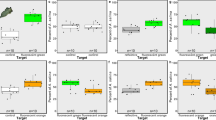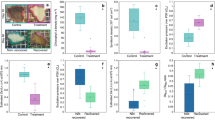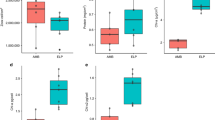Abstract
All reef-forming corals depend on the photosynthesis performed by their algal symbiont, and such corals are therefore restricted to the photic zone. The intensity of light in this zone declines over several orders of magnitude—from high and damaging levels at the surface to extreme shade conditions at the lower limit1. The ability of corals to tolerate this range implies effective mechanisms for light acclimation and adaptation2. Here we show that the fluorescent pigments3,4,5,6,7,8,9 (FPs) of corals provide a photobiological system for regulating the light environment of coral host tissue. Previous studies have suggested that under low light, FPs may enhance light availability4,5. We now report that in excessive sunlight FPs are photoprotective; they achieve this by dissipating excess energy at wavelengths of low photosynthetic activity, as well as by reflecting of visible and infrared light by FP-containing chromatophores. We also show that FPs enhance the resistance to mass bleaching of corals during periods of heat stress, which has implications for the effect of environmental stress on the diversity of reef-building corals, such as enhanced survival of a broad range of corals allowing maintenance of habitat diversity.
This is a preview of subscription content, access via your institution
Access options
Subscribe to this journal
Receive 51 print issues and online access
$199.00 per year
only $3.90 per issue
Buy this article
- Purchase on Springer Link
- Instant access to full article PDF
Prices may be subject to local taxes which are calculated during checkout




Similar content being viewed by others
References
Jokiel, P. L. Solar ultraviolet radiation and coral reef epifauna. Science 207, 1069–1071 (1980).
Falkowski, P. G., Jokiel, P. L. & Kinzie, R. A. III in Coral Reefs Vol. 25, Ecosystems of the World (ed. Dubinsky, Z.) 89–107 (Elsevier, Amsterdam, 1990).
Kawaguti, S. On the physiology of corals. VI. Study of the pigments. Contrib. Palao Trop. Biol. Station 2, 616–673 (1944).
Kawaguti, S. Effect of the green fluorescent pigment on the productivity of the reef corals. Micronesica 5, 313 ( 1969).
Schlichter, D., Fricke, H. W. & Weber, W. Light harvesting by wavelength transformation in a symbiotic coral of the Red Sea twilight zone. Mar. Biol. 91, 403–407 (1986).
Mazel, C. H. Spectral measurements of fluorescence emission in Caribbean cnidarians. Mar. Ecol. Prog. Ser. 120, 185–191 (1995)
Salih, A., Hoegh-Guldberg, O. & Cox, G. in Proc. Aust. Coral Reef Soc. Conf. (eds Greenwood, J. G. & Hall, N. J.) 217–230 (School of Marine Science, University of Queensland, Brisbane, 1998).
Matz, M. V. et al. Fluorescent proteins from nonbioluminescent anthozoa species. Nature Biotechnol. 17, 969– 973 (1999)
Dove, S. G., Hoegh-Guldberg, O. & Ranganathan, S. Major colour patterns of reef-building corals are due to a family of GFP-like proteins. Coral Reefs 19, 197–204 (2000).
Dove, S. G., Takabayashi, M. & Hoegh-Guldberg, O. Isolation and partial characterization of the pink and blue pigments of Pocilloporid and Acroporid corals. Biol. Bull. 189, 288–297 (1995).
Shimomura, O., Johnson, F. H. & Saiga, Y. Extraction, purification, and properties of aequorin, a bioluminescent protein from the luminous hydromedusan, Aequorea. J. Cell. Comp. Physiol. 77, 305– 312 (1962).
Takabayashi, M. & Hoegh-Guldberg, O. Physiological and ecological differences between pink and brown genotypes of the reef-building coral Pocillopora damicornis. Mar. Biol. 123 , 705–714 (1995).
Veron, J. E. N. Corals of Australia and the Indo-Pacific (Angus & Robertson, Sydney, 1986).
Long, S. P., Humphries, S. & Falkowski, P. G. Photoinhibition of photosynthesis in nature. Annu. Rev. Plant Physiol. Plant Mol. Biol. 45, 633– 662 (1994).
Brown, B. E. et al. Diurnal changes in photochemical efficiency and xanthophyll concentrations in shallow water reef corals: evidence for photoinhibition and photoprotection. Coral Reefs 18, 99– 105 (1999).
Hoegh-Guldberg, O. & Jones, R. Diurnal variability in photoinhibition and photoprotection in the symbiotic zooxanthellae of corals. Mar. Ecol. Prog. Ser. 22, 520– 519 (1999).
Brown, P. E. et al. Bleaching patterns in reef corals. Nature 404, 142–143 (2000).
Salih, A., Hoegh-Guldberg, O. & Cox, G. in Proc. Aust. Coral Reef Soc. Conf. (eds Greenwood, J. G. & Hall, N. J.) 206–216 (School of Marine Science, University of Queensland, Brisbane, 1998).
Jones, R., Hoegh-Guldberg, O., Larkum, A. W. D. & Schreiber, U. Temperature induced bleaching of corals begins with impairment of dark metabolism in zooxanthellae. Plant Cell Environ. 21, 1219–1230 (1998).
Schreiber, U., Gademan, R., Ralph, P. J. & Larkum, A. W. D. Assessment of photosynthetic performance of Prochloron in Lissoclonium patella in hospite by chlorophyll fluorescence measurements. Plant Cell Physiol 38, 945–951 (1997).
Glynn, P. W. Coral bleaching: ecological perspective. Coral Reefs 12, 1–17 (1993).
Hoegh-Guldberg, O. Coral bleaching, climate change and the future of the world's coral reefs. Mar. Freshwat. Res. 50, 839– 866 (1999).
Kühl, M. & Jørgensen, B. B. Spectral light measurements in microbenthic phototrophic communities with a fiber-optic microprobe coupled to a sensitive diode array detector. Limnol. Oceanogr. 37, 1813–1823 (1992).
Kühl, M. et al. Microenvironment and photosynthesis of zooxanthellae in scleractinian corals studied with microsensors for O2, pH and light. Mar. Ecol. Prog. Ser. 117, 159–172 (1995).
Falkowski, P. G. & Dubinsky, Z. Light-shade adaptation of Stylophora pistillata, a hermatypic coral from the Gulf of Elat. Nature 289, 172–174 (1981).
Rowan, R. et al. Landscape ecology of algal symbionts creates variation in episodes of coral bleaching. Nature 388, 265– 269 (1997).
Shick, J. M., Lesser, M. P. & Jokiel, P. L. Effects of ultraviolet radiation on corals and other coral reef organisms. Glob. Change Biol. 2, 527–545 (1996).
Lesser, M. P. Elevated temperature and ultraviolet radiation cause oxidative stress and inhibit photosynthesis of symbiotic dinoflagellates. Limnol. Oceanogr. 41, 271–283 ( 1996).
Iglesias-Prieto, R. & Trench, R. K. Acclimation and adaption to irradiance in symbiotic dinoflagellates. II. Response of chlorophyll-protein complexes to different photon-flux densities. Mar. Biol. 130, 23–33 (1997).
Dunlap, W. C. & Shick, J. M. Ultraviolet radiation-absorbing mycosporine-like amino acids in coral reef organisms: a biochemical and environmental perspective. J. Phycol. 34, 418– 430 (1998).
Acknowledgements
We thank the Great Barrier Reef Marine Park Authority, especially J. Oliver, R. Berkelmans, M. Russell and U. Engelhart, for financial and logistic support. This work was also supported by an Australian Research Council (ARC) SPIRT PhD award (A.S.) and ARC grants (O. H.-G. and A.L.). M.K. was supported by the Danish Natural Science Research Council. We thank the staff of Heron and One Tree Island research stations for assistance during fieldwork.
Author information
Authors and Affiliations
Corresponding author
Rights and permissions
About this article
Cite this article
Salih, A., Larkum, A., Cox, G. et al. Fluorescent pigments in corals are photoprotective. Nature 408, 850–853 (2000). https://doi.org/10.1038/35048564
Received:
Accepted:
Issue Date:
DOI: https://doi.org/10.1038/35048564
This article is cited by
-
Coral fluorescence: a prey-lure in deep habitats
Communications Biology (2022)
-
Limited acclimation of early life stages of the coral Seriatopora hystrix from mesophotic depth to shallow reefs
Scientific Reports (2022)
-
Evaluation of fluorescence-based viability stains in cells dissociated from scleractinian coral Pocillopora damicornis
Scientific Reports (2022)
-
The role of the endolithic alga Ostreobium spp. during coral bleaching recovery
Scientific Reports (2022)
-
High light quantity suppresses locomotion in symbiotic Aiptasia
Symbiosis (2022)
Comments
By submitting a comment you agree to abide by our Terms and Community Guidelines. If you find something abusive or that does not comply with our terms or guidelines please flag it as inappropriate.



